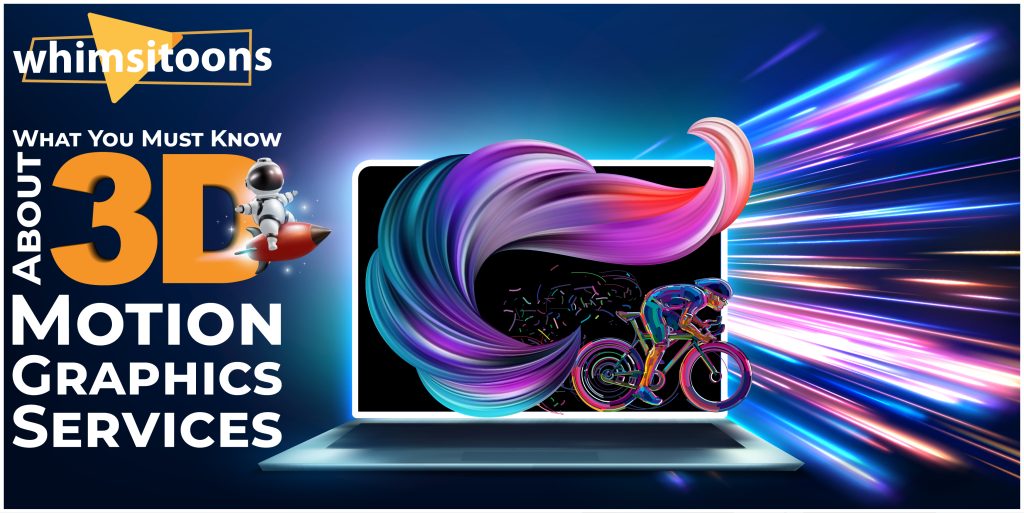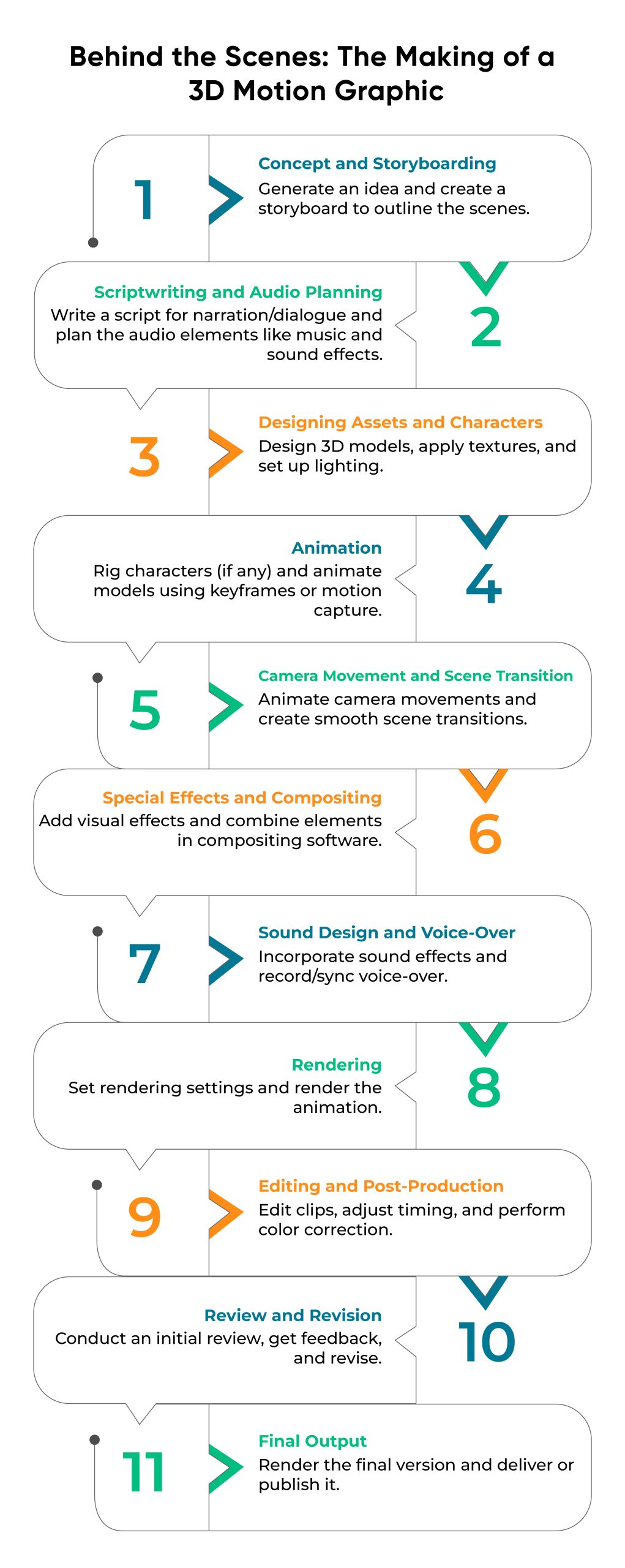What You Must Know About 3D Motion Graphics Services

Ever wonder how the incredible animations in classic films or hit advertisements are produced?
That’s the power of 3D motion graphics.
But behind the scenes, there is a world of skill, planning, and technology that makes it all possible.
Want to learn more about 3D motion graphics and from where you can get 3D motion graphics services, then stick with us till the end of this blog!
Understanding 3D Motion Graphics
3D motion graphics are more than just animation; they’re a combination of art, design, and technology.
They bring stories to life through a blend of 3D modeling, texturing, and animation techniques.
This technique creates immersive and interactive visual experiences that captivate audiences across various platforms.
Why 3D Motion Graphics?
- Enhanced Engagement: They captivate viewers with their realism and dynamics.
- Versatility: From commercials to educational content, they fit every narrative.
- High Recall Value: Their visual appeal makes the content memorable.
- Innovation: They push the boundaries of traditional storytelling.
The Process Behind the Magic
Creating 3D motion graphics is a blend of artistry and technical prowess, a journey from a mere concept to a captivating visual spectacle.
This difficult process involves several steps, each requiring a unique set of skills and tools.
Let’s check deeper into each stage to understand the magic behind 3D motion graphics.

Conceptualization:
Every great visual starts with an idea.
This initial phase is all about brainstorming and conceptualizing.
It’s where creators and clients come together to discuss visions, objectives, and messages they want to convey.
Key elements like themes, color schemes, and overall aesthetics are decided here.
Storyboarding follows, transforming these ideas into a visual script.
It’s like a comic strip, where each frame represents a key moment in the animation, providing a roadmap for what will be created.
3D Modeling:
Once the storyboard is approved, the next step is 3D modeling.
This is where artists build the characters, objects, and environments that will exist in the 3D world.
Using sophisticated software like Autodesk Maya or Blender, modelers precisely point out every detail, ensuring that each element is both aesthetically pleasing and true to the storyboard.
This stage sets the foundation for the entire animation, making it crucial for the overall success of the project.
Texturing:
After modeling comes texturing, where these models gain color and surface characteristics.
Texturing artists apply images, known as textures, to the 3D models.
This step is vital for adding realism – be it the roughness of a rocky surface or the smoothness of a character’s skin.
It’s not just about color; it involves tweaking reflectivity, opacity, and bump mapping to create a believable world.
Rigging:
Rigging is the next crucial phase, often considered the backbone of 3D animation.
In this stage, riggers create the skeletons for the 3D models.
These skeletons, or rigs, are what animators use to make the models move.
Rigging determines how a character or object can be animated, including its range of motion, ensuring movements are both realistic and aligned with the project’s artistic vision.
Animation:
Now, the stage is set for the actual animation.
Animators use the rigs to breathe life into the models, moving them according to the storyboard.
This phase requires a keen understanding of movement and timing.
Animators are like digital puppeteers, making sure each motion, whether a subtle facial expression or a dynamic action sequence, contributes to the story’s emotional and narrative flow.
Lighting and Rendering:
Lighting is the unsung hero of 3D animation.
Proper lighting can make a scene feel warm or cold, inviting or unpleasant. It adds depth, enhances textures, and sets the overall mood.
Following lighting, rendering transforms all the elements – models, textures, movements, and lighting – into the final video.
This process can be time-consuming, depending on the complexity of the scenes and the quality of the render.
High-quality renders provide stunning visuals but require more processing power and time.
Post-Production:
In post-production, the rendered sequences are assembled to create the final product.
This stage includes editing, adding sound effects, voice-overs, and music, and sometimes integrating the animation with live-action footage.
Color correction and various visual effects are also added during this stage to enhance the visual appeal and ensure that the final product aligns perfectly with the initial vision.
This detailed, step-by-step process shows how 3D motion graphics are not just a technical endeavor but a form of art.
Each stage, from conceptualization to post-production, plays a vital role in turning creative visions into captivating visual stories.
It’s this precise and creative process that defines the magic behind 3D motion graphics.
Where 3D Motion Graphics Shine
The versatility of 3D motion graphics makes them ideal for various sectors.
- Advertising and Marketing: For creating eye-catching commercials and digital ads.
- Film and Television: In title sequences, special effects, and animated features.
- Education and Training: For explainer videos, architectural walkthrough services, and interactive learning materials.
- Gaming and Virtual Reality: Enhancing user experience with immersive graphics.
Comparison Between Traditional 2D and 3D Motion Graphics
| Aspect | 2D Motion Graphics | 3D Motion Graphics |
| Visual Depth | Limited | High |
| Realism | Moderate | Exceptional |
| Interactivity | Basic | Advanced |
| Production Time | Generally Less | More Time-Consuming |
| Cost | Lower | Higher |
The Future is 3D
The future of visual content is surely 3D.
With advancements in technology, we’re seeing more realistic and interactive graphics that are not just limited to entertainment but are also revolutionizing fields like medicine, architecture, and education.
Trends to Watch
- Virtual Reality Integration: Merging 3D motion graphics with VR for immersive experiences.
- AI in Motion Graphics: Using AI to automate and enhance the animation process.
- Interactive Web Graphics: Enhancing user engagement on websites with interactive 3D elements.
Choosing the Right 3D Motion Graphics Service
Selecting the right service provider is crucial.
Here are a few tips:
- Portfolio Review: Always check their past work for quality and creativity.
- Technical Expertise: Ensure they have the necessary skills and software.
- Customer Testimonials: See what earlier clients have to say..
- Budget and Timeline: Discuss your budget and required timelines upfront.
Integration with Other Digital Marketing Strategies
Incorporating 3D motion graphics into a broader digital marketing strategy is more than just an innovative approach; it’s a powerful way to create a cohesive and impactful online presence.
When integrated effectively, 3D motion graphics can increase the effectiveness of various digital marketing channels and tactics.
Let’s see how this integration can be achieved to maximize the impact of your marketing efforts.
Enhancing Social Media Engagement
Social media platforms are visual-centric spaces, where engaging content reigns supreme.
Integrating 3D motion graphics into your social media strategy can significantly boost engagement levels.
These graphics can be used to create eye-catching posts, stories, and ads that stand out in a crowded feed.
Whether it’s for product showcases, event promotions, or brand storytelling, 3D motion graphics can elevate the visual quality of your social media content, making it more shareable and memorable.
Boosting Email Marketing Campaigns
Email marketing remains a highly effective channel for directly reaching your audience.
By incorporating 3D motion graphics in emails, you can increase open and click-through rates.
These graphics can be used to create visually appealing headers, product demonstrations, or as part of interactive email content.
They add a dynamic element to otherwise static email campaigns, capturing the recipient’s attention and encouraging engagement.
Enhancing Website and SEO Performance
Your website is often the first point of interaction with your brand.
Incorporating 3D motion graphics can enhance user experience, leading to increased dwell time and better engagement rates – both important factors for SEO.
These graphics can be used on landing pages, as part of interactive guides, or to explain complex products and services.
Not only do they make the website more visually appealing, but they also help in conveying information in a more engaging and digestible manner.
Complementing Content Marketing
Content marketing is about telling your brand’s story, and what better way to do that than through captivating visuals.
Integrating 3D motion graphics with your content marketing efforts can help in illustrating complex ideas, showcasing product features, or simply adding a visual element to your blogs and articles.
This integration can make your content more engaging, increase shareability, and help in establishing your brand as a forward-thinking, innovative player in your industry.
Enhancing Online Advertising
Online advertising is highly competitive, and standing out is key to success. 3D motion graphics can be a game-changer in this arena.
By using these graphics in your online ads, you can create more impactful and eye-catching campaigns.
Whether it’s banner ads, video ads, or interactive ads, combining 3D motion graphics with expert video editing services ensures a cohesive and highly engaging visual experience, leading to higher click-through rates and better campaign performance.
Leveraging in Influencer Collaborations
Influencers are a pivotal part of modern digital marketing strategies.
Collaborating with influencers and providing them with 3D motion graphics content can add a new dimension to their posts or videos.
This not only enhances the content quality but also aligns your brand with innovation and creativity, extending your reach and appeal to the influencer’s audience.
Integration with Analytics and Feedback
Finally, integrating 3D motion graphics with analytics tools allows for tracking and measuring their effectiveness in real-time.
You can gather valuable insights into how audiences interact with your 3D content, which can inform future marketing strategies and content creation.
By strategically integrating 3D motion graphics into your digital marketing strategy, you can create a more engaging, memorable, and effective online presence.
This integration goes beyond mere aesthetics; it’s about leveraging the power of visual storytelling to enhance every facet of your digital marketing efforts, ensuring that your brand not only captures but also retains audience attention in the digital space.
Conclusion
3D Motion Graphics Services are not just about creating content; they’re about crafting experiences that resonate with audiences.
As technology evolves, so does the scope of these services, making them an invaluable tool for storytellers and marketers alike.
Whether it’s for advertising, education, or entertainment, 3D motion graphics are set to redefine our visual landscape.
Embrace this change and let your stories take a new dimension!
FAQs
Q 1: How cost-effective are 3D motion graphics services?
They can be cost-effective in the long run, especially considering the engagement and recall value they offer.
Q 2: Can 3D motion graphics be used for small-scale projects?
Absolutely! They can be scaled to fit projects of any size, from startups to large corporations.
Q 3: How long does it take to create a 3D motion graphic?
It varies based on complexity, but it generally takes several weeks to a few months.
Q 4: Are 3D motion graphics compatible with all digital platforms?
Yes, they can be optimized for various platforms, including web, TV, and mobile.
Q 5: Can I be involved in the creative process?
Most service providers welcome client input during various stages of the project.










